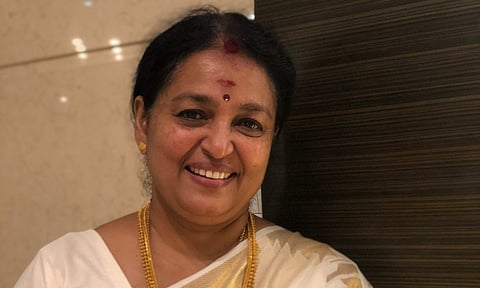

It's hard to imagine Amitabh Bachchan without that deep, majestic baritone voice. It's Rani Mukerji's unique voice that made her stand out among her peers. For a novice like Arjun Das, it's his voice that shot him to fame. It's the tremble in Mammootty's voice that tugs at our heartstrings. So for an actor, voice is a form of identity. But not always do actors have the apt voice for a given character. That's when efficient dubbing artists like Sreeja Ravi step in. A veteran of over 2000 films, Sreeja is still among the most sought-after voice actors in South Indian cinema. Occasionally, she has also demonstrated her impeccable acting skills in front of the camera. One such instance was in the recent Eid release, Kadina Kadoramee Andakadaham (KKA) where she plays a Muslim woman—a mother of three—waiting longingly for her expat husband's return. Sreeja beautifully conveys the wife's yearning, and it's her emotionally charged performance that's one of the pillars of the film. Do years of experience in voice acting come in handy while performing? "It does. A good voice actor will be performing in front of the mic while rendering the lines. That's how I've been doing it all these years, so yes, it does help me. But I still consider myself a budding actor who is trying to learn the craft," says a modest Sreeja.
Sreeja's journey in cinema began by dubbing for child actors. Though her mother—also a dubbing artist—wanted Sreeja to be an actor, opportunities rarely came her way. She cites her lack of 'conventional' looks as the reason. "Heroines during that era were expected to be of a particular body type. A heroine invariably had to be glamorous. Hailing from a poor background, I didn't have the typical heroine-like features. So I faced a lot of rejections. It was only years later, after marriage that I started getting some good roles", recalls Sreeja.
Though Sreeja had done a few noteworthy roles in Tamil and Malayalam, she was waiting for something substantial, and that's when KKA was offered. "I was overseeing the Telugu to Malayalam dubbing of Shaakuntalam when Muhashin approached me with this role. He gave a brief description of my character, and I instantly loved it. Even though I didn't know it would be such a prominent role, I wanted to do it. But then I couldn't afford to spare the dates as Shaakuntalam's release was closing in, and a lot of portions were still left to be dubbed. I was in a serious dilemma and shared it with Shaakuntalam's lead actor, Dev Mohan. It was Dev who instilled the confidence in me to take up the role."
Shalini, Kavya Madhavan, Bhavana, Divya Unni, Gopika, Devayani, Nayanthara, Roma... These are some of the actors to whom Sreeja frequently lent her vocals. It must be noted that they all belonged to different languages and age groups. Such is Sreeja's versatility that she used to dub for multiple characters in the same film and, at times, in the same scene. "I dubbed for both Padmapriya and Kavya Madhavan in Vadakkumnadhan, and Kavya and Bhavana in Twenty:20. In Pookkalam Varavayi, I dubbed for both the lead actor, Sunitha, and 4-year-old Baby Shamili. It's quite a challenge as we've to bring a lot of variations to make each character sound distinct," says Sreeja while also elaborating on the other challenges in the field. "Unlike actors, dubbing artists usually get a brief about the scene just before the 'take'. You've to be spontaneous and, at the same time, have good clarity. I make it a point to speak to the director or writer to try and understand the character's nature and a basic idea of the storyline. It's important to have that understanding, but unfortunately, I don't see many doing that today. As a result, the emotions don't get conveyed effectively," observes Sreeja, adding, "Anyone can dub, but performing in front of the mic is an altogether different challenge."
It's often said that an actor's job is complete only when they dub for themselves. One would expect a veteran voice actor like Sreeja to oppose this school of thought, but she concurs. "I agree because I am also into acting now. I can't imagine someone else dubbing for me. There have been times when directors wanted a different voice for my character because they thought my voice lacked the depth and base of a mother. Some wanted it changed because they felt my voice reminded them of Kavya or Shalini. It's ultimately the director who takes a call on the kind of voice they want for a particular character. But if you ask me, it would be perfect if actors can balance their performance and voice acting skills."
With filmmakers opting for a realistic treatment and the advent of advanced technologies like the sync sound, dubbing is now a fading art, admits Sreeja. "Dubbing is now common only in films starring other language actors. Times have changed with the audience embracing actors with their own voices, regardless of its depth or base. There are no more dramatic dialogues. Characters speak the language of the everyday person. So it's indeed a tough phase for dubbing artists, but those willing to learn and adapt will certainly be able to stand the test of time," signs off Sreeja on a hopeful note.